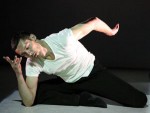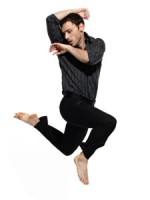Title
The third-floor dance studios were buzzing in late October. In one, 18 dancers, sporting socks and kneepads, sat on the floor with legs outstretched in a close line-up, meticulously perfecting a fast, intricate unison sequence of head and upper body movements, tightly timed to a three-beat count. Next door, dancers were cascading to the floor sequentially, rising swiftly and dashing out of the way of other oncoming bodies. Down the hall, a mass of dancers organized into lines of three or four navigated dense traffic patterns to the insistent, chugging rhythms of Steve Reich’s music. And in yet another studio, a large ensemble strode forward with a cowboy swagger, then went through a swift, nimble sequence full of surprising gestures, accompanied by a Johnny Cash song.
Body
It’s that time of year again, when every student in the Dance Division is involved in New Dances, and ingenious, surprising results can be anticipated. Launched in 2003 by Lawrence Rhodes, the division’s artistic director, this project pairs up each class with a choreographer, and sets the creative juices flowing. For the freshmen, the experience is their first opportunity to come together as a class, after being divided into separate groups for the Composers and Choreographers Workshop. But just as Rhodes had envisioned when he created New Dances, “It’s been a very consolidating and wonderful experience for all the classes.”
This year’s quartet includes three of New York City’s busiest and most interesting younger choreographers, and one who brings in a notably different European perspective. Rhodes keeps the needs, and previous experiences, of each class in mind when he plans his selections. “I try to look at what people have done already in the School, and try to give them different sorts of challenges.”
The first-year students are working with Andrea Miller—a Juilliard alumna (class of 2004) who spent two years with Tel Aviv’s Batsheva Ensemble, performing the works of fellow alum Ohad Naharin, before returning to found her company, Gallim Dance. “She came back with a lot of energy and skill, and a lot of information that I thought would be terrific for the freshmen to get into,” said Rhodes. “Her experience with Ohad, and the way he functions and works—I thought it would be good for them to be introduced to that sooner, rather than later. It was a very easy choice—to bring back an alum with pertinent information for a young class.”
A glimpse into Miller’s rehearsals, still at an early stage in the two-month process, revealed a room seething with vigorous energy and dancers taking risks. One dancer after another executed a run-slide-fall maneuver, as Miller urged them to fall into awkward positions. Their next move was to spring right back up, but Miller requested, and demonstrated with agility and spontaneity, how she wanted them to get off the floor “like a cat”—rather than taking a safer, more predictable approach.
“The freshmen are so excited, and so invested in being there. They’re really receptive, absolutely available to testing out the things that we’re investigating together. It’s amazing to have that kind of energy in the studio,” Miller said several days later in a phone interview. “During the first few rehearsals, they seemed like a big mob. At the same time, I saw them a little bit like soldiers, because they really are—Juilliard is a form of boot camp. They have to learn, and get things right. And they’re 18, military age. I also started thinking of student riots.”
“At this point, we’re playing with a lot of material,” she added. “I’m trying to take a look at chaos and order. There are strong lines and formations and exercises, and then that system breaks down into chaos. There is a certain sense of potential for danger at any point.”
Fabien Prioville, a French dancer who performed from 1999 to 2006 with Pina Bausch’s Tanztheater Wuppertal and is currently a freelance choreographer residing in Düsseldorf, is the name least known to New York dance audiences among the four. Rhodes considers him “a very bright talent,” and paired him with the second-year class. “I thought, they’re going to get a lot from this, because it’s a very beautiful and strong way of coordinating and putting together different movement and images. Bringing something of the work of Pina Bausch, also a Juilliard alum, into the school would be good.”
During an interview between rehearsals, Prioville explained, “I felt that, coming from Europe, I wanted to come with all my influences and background, and all the things that inspired me—and present that to them. And then find a way we could work this out together, so they can feel comfortable and secure. My way of moving is a very different approach from theirs, and I’m using some of my choreography to teach them that.”
Drawing inspiration from the 1983 Ettore Scola film Le Bal, Prioville is working with the central idea of a birthday party. “It’s about ballroom dancing. I was interested to use modern dance and contextualize it in a room where there will be social dancing—to use modern movement to create this atmosphere. Couples are getting together, connections are made, and then it dissolves. There is a birthday girl. She starts with a list of wishes. It is Tanztheater, so they do some dancing, some acting—they speak in the piece.”
In one early rehearsal, the dancers paired up into male-female couples, made transitory connections, and moved on. “Approach, and see if you fit together,” Prioville urged them. “I’m trying to make them feel more concerned about the movement they do, make them understand that it is a language. It is of course about technique, but it’s really about trying to express something with your body,” he explained later.
The third-year class is working with Larry Keigwin, who created the exhilarating Runway for the seniors on last year’s program. “They’re really spectacular. They surprise me with their physicality and what they create. The climate that we set in the studio, it was very playful from the beginning. There’s an energy that’s conducive to creating freely,” Keigwin said by phone early in his rehearsal period. “We are completely collaborating in generating the material. I sometimes like to think of it as making a dress: they are making the fabric, and I’m sewing it together.”
He’s the one choreographer for whom the music—Steve Reich’s Six Marimbas—was his starting point, and who was already certain of his dance’s title: Colony. “Once I started collaborating with the dancers and developing the material, I saw a movement that reminded me of an insect. I’ve always had a fascination with ants, their power of community, and how organized they can be. One thing led to the next—I looked at ant colonies, and there are so many beautiful patterns. They’re very social insects.”
Space-filling patterns and surging energy were in evidence at an early rehearsal, culminating in a sequence where dancers joined in an accumulating snaking line that swelled into a powerful circular exit.
Also making a return to New Dances is Aszure Barton, who created a work for the 2006 program. Canadian-born but based in New York, she leads her own highly individual company but is also much in demand these days, having recently choreographed for American Ballet Theater and the National Ballet of Canada. In selecting Barton for a repeat appearance, Rhodes was responding to a specific request: last year’s third-year students had expressed a particular interest in working with Barton, and he has now matched them up with her for this program.
“It was something coming from the students that I responded to in a positive way,” Rhodes noted. “I thought Aszure and this group would be a good match. She explained how busy she was this fall, but said ‘I love to work with your dancers.’”






